|
Olympics in Beijing, Arirang in North Korea |
[Editor's note: Although this was sent to me in 2008, I think it's still relevant, as a fascinating look at one country where westerners almost never go, and at another that has opened itself up to the west only in the last few decades, after two generations of near-total secrecy. I sent it off for posting when I got it, but apparently the computer ate it. -Shel Horowitz, Editor,Global Travel Review/Peace and Politics]
After Cosy retired, we decided to celebrate by going somewhere far, far away from our little "mouse house" in Rumney NH. Asia in general has always intrigued us, but we have really only spent time in the Philippines, since Cosy's family is there. This time, we would satisfy our curiosity about China and North Korea. It looked like the optimal year to visit both places. China has arrived as one of the key nations in the world, and would be putting its best foot forward with the Beijing Olympics. North Korea (formally, Democratic People's Republic of Korea, or DPRK) was starting to draw western visitors with its Arirang Festival. It so happened that the Olympics and the Festival would overlap this year, and it might be possible to get a visa to DPRK in Beijing. We explored this on the internet through www.korea-dpr.com starting in the spring. This website represents official DPRK and the Korean Friendship Association to the internet community, although I believe it is actually maintained from Singapore. The other possibility was Koryo Tours, a British-based outfit catering to curious westerners. For many reasons, we preferred to stay with the more officially connected group, and we were not sorry. In all, we spent 6 days in China and 4 days in the DPRK, just enough to pique further curiosity. In the following account, I will dwell more on the DPRK, since not many visit there, and few places on earth are more inaccessible to the US tourist on many levels, physical and psychological. We cannot tell all and show all in this brief report. We have hundreds of pictures and impressions of both Beijing and Pyongyang, and it was difficult to choose among them for this account.

One World, One Dream
Why China? Why DPRK? A better question would be why not. Of course, there is the attraction of very different cultures much older than ours, with the intriguing modifications that modern history, heroic or tragic, has wrought. We share the sentiment of the Beijing lighted billboard, "One World One Dream", and felt like we must warm our hands before these campfires while we had the chance. Campfires that just over a half century ago were unapproachable due to civil wars in which our country had chosen to interfere - indirectly by logistical and diplomatic support of the Kuomintang in one case and directly by invasion of the Korean peninsula in the other. We knew the brief time we spent in both countries would not make us experts, but we just felt we had to do this trip. Any deeper knowledge we might have about either place would come from study, past and present. Some of what we would see on the trip would guide our future studies, and especially in the case of the DPRK, our activities to realize the sentiment on the Beijing billboard. If this short account of a short journey seems too positive, there are many others who amplify all the flaws and commercialize them. We didn't have time for that and frankly wanted to see the best that Beijing and Pyongyang could offer, and we were not disappointed. Make the most of it!

Beijing Railway Station
This is the famous Beijing Railway Station. Of course we flew in, but one of our DPRK tour companions, a Dutch lawyer ("Rudi"), actually arrived in China here. A train buff, he made the incredible two week journey entirely on rails (transferring from time to time, of course). We stayed in the International Youth Hostel just across the street from the train station. The excellent subway system had a station adjacent to the front entrance of our quarters, and inexpensive and delicious eateries were just around the corner. The fabulous six-story Beijing Duck Restaurant was just 3 subway stops away. Two grocery stores were across the street, as was a branch of the Bank of China for convenient money conversion (yuan = about 15 cents). Since we were there during the Olympics, hotel rates had been jacked 5x normal in most places - one of the reasons why we settled on the youth hostel rather than a conventional hotel, which would have cost $300 a night and up. The hostel would have been very inexpensive (about $9 per night) for the twenty-something back-packer set, but since we are senior citizens, we opted for a private room (normally $37 a night). Due to the Olympics, we paid $162 a night. Rooms were very clean and large, with television and individual air conditioning. The included breakfast was an all-you-can-eat buffet featuring delicious Chinese food plus some western items. Highly recommended by yours truly and my mouse spouse.

Cosy as Tourist
Here is Cosy in Beijing, eclipsed by her Kodak. Am I the target, or some of the impressive modern architecture of New China? Three shots to follow prove the latter, since I am old news by now.

Modern Beijing Architecture - A

Modern Beijing Architecture - B

Modern Beijing Architecture - C
Contrary to the bad press China got before the Olympics (and still gets, they won't give it a rest), there was no smog. The air was relatively clean for a city of 30,000,000 - not up to Rumney NH standards, but much better than NYC or Los Angeles, for example. Cities in Asia are growing faster than anywhere in the world, partly because the rural population is relocating for better opportunities. If you want to experience true city air pollution, I suggest a brief visit to Manila. Private cars are still rather few in Beijing, about half are taxis. These we avoided, after stories about cheating that would make a NYC cabbie blush. Unless you buy at a state-run store, you are a fool if you do not bargain. Cosy is good at it, I am repelled by the process; she bought silk at 1/3 the marked price. Socialism in China? Well, yes - but "mixed" would better describe it - maybe even "mixed-up" at times - China has retreated somewhat from its early ideals, mistaken or otherwise. The only big picture we saw of Mao was in Tiananmen Square. He is on the money.
The subway was our means of getting around, and it was very inexpensive (2 yuan = 30 cents) and went almost anywhere in town. Directions and announcements are in both Chinese and English; we never felt lost. There are three or four interlocking lines; transfers are free, but sometime there is a lot of walking. Security was ever-present; your bags were X-rayed at both subway entries and exits. Everyone was very courteous and efficient; many tried English, I can only say it was better than our Chinese.

Womens Gymnastic Finals
This was the Olympic event we came for - the Women's Gymnastics Finals! Tickets were not cheap (about $380 each over the internet) since this was a much sought-after event. At that, our seats were way up in the bleachers, as can be seen from the photo. Four events were more or less going on at the same time, and it was easier to follow later on television. But being there was special. The enthusiasm and good spirits of the Chinese were contagious, and their hard work paid off in securing the highest gold medal count in the Olympics.

Parallel Beam
A young lady here on the parallel beam.
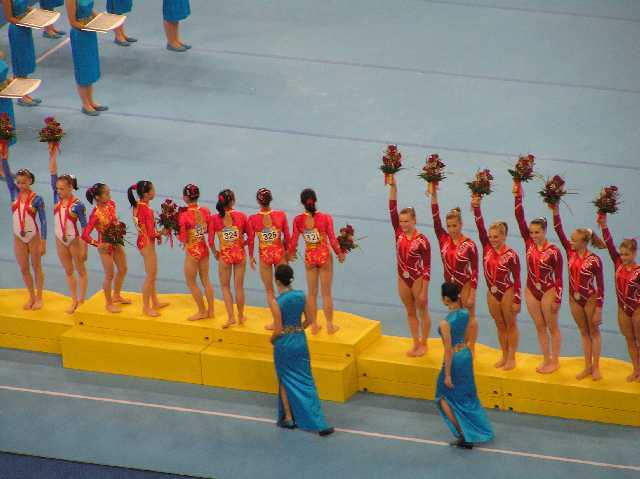
Winners
The Winners! China took the gold, US took silver (right), and Romania (left) bronze. Some Americans sitting next to us bolted from the stadium before the award ceremony, they just couldn't stomach second place to the Chinese. They continued the embarrassment by claiming that the tiny Chinese ladies were underage! This disgusting "controversy" went on for several days in the US media after we returned from our trip.

The Great Wall
What would a trip to China be without walking the Great Wall? We signed up for a day trip to a section of it that runs near Beijing. This also gave us a chance to see the countryside and small villages on the way, which often reminded Cosy of the Philippines. On the way back, we stopped at a jade carving institution and a silk factory; Cosy bought some exquisite material here, but paid full price since it was a state enterprise.

Pyongyang, Capital of DPRK
This is Pyongyang, capital of the Democratic Peoples' Republic of Korea (DPRK) - unofficially known as North Korea. Obtaining a DPRK visa was not routine. The China visa can be gotten in a few hours by applying to the Chinese Embassy in New York City. It took months in the case of DPRK, and for us it included submission of our resumes for background check. The DPRK boasts the tightest security of any country in the world, and they are especially vigilant about Japanese and US citizens for historical reasons. Both espionage and mendacious portrayal of their country by unsympathetic foreigners are vital concerns. But there is a special problem for Japanese, who held Korea in bondage for forty years, only releasing their grip at the end of World War II. In the late forties, the Korean civil conflict developed into what we call the Korean War (June 1950) through US intervention. Unknown to many Americans, the US has refused to sign a peace treaty with the DPRK after the 1953 cease-fire, and the Koreans are still concerned about a US attack. Most Koreans lost family members in that war, over two million died, mostly civilians. We were told that for every square meter of Pyongyang, two bombs on average had fallen. It was pulverized worse than anything Europe had seen, comparable to the atomic bombing of Japan. Most of this occurred towards the end of the conflict, when the 38th parallel had been reestablished, so it was viewed as hateful spite by Koreans. Other large cities in DPRK received similar treatment. So the city you see in the picture was completely rebuilt from scratch, most of it within 12 years. Western experts had predicted 100 years. It is no wonder that the DPRK strikes the visitor, especially from the US, as the New Sparta, ever prepared to defend itself from destruction and invasion. Although their prevalence is played up in western media, you can indeed find dramatic posters of US and Japanese military figures being annihilated by heroic Korean soldiers. Events over half a century ago are burned into the psyche of every North Korean. School children know how to operate a machine gun and how to throw a grenade. Even kiddie cartoons show warfare between "good" animals (chipmunks and hedgehogs) and "bad" ones (weasels and rats). There are no street signs or names on buildings, other than the occasional banner or picture of the departed Great Leader (Kim Il Sung) or his son the Dear Leader (Kim Jong Il). Aside from the possibility of getting lost, a foreign visitor is not allowed out alone and unaccompanied. The reason is clearly for security purposes. But for all this, the treatment of foreigners as individuals, even US and Japanese citizens, is most cordial and friendly.

Pyongyang Architecture

Street Scene
You heard no traffic in the DPRK? Here our tour bus is caught in a major traffic jam; thousands off to rehersals - either the Arirang Festival or the 60th DPRK founding anniversary celebration to come later. Private cars are not seen, public transportation is everywhere; mostly articulated electric trolly buses, a few trams, and the deepest subway I have ever seen, including one similar in Moscow. What cars and trucks there are belong to government and business entities. Therefore, the streets are clean and auto traffic is light. Major intersections are refereed by attractive young ladies in uniform. On the streets were huge numbers of people in folk costumes involved in the Arirang Festival - or Games - although this is a misnomer, since the competition is off-stage between different groups around the country to have a place in the show, which is held daily for a little over a month from August through the first week of September. Kim Jong Il initiated Arirang in 2002, which rapidly became a proud tradition, drawing many foreign visitors. So far, the bulk of tourism is Chinese, having a special historical relationship with the DPRK, but there are many Europeans now discovering Arirang.

May Day Stadium
The Arirang Festival is held in the May Day Stadium, with 150,000 capacity. The name "Arirang" is that of the most revered folk song of Korea, north and south, which sets the core theme and tone of all performances. The show lasts one hour and a half, no intermissions. One breathtaking act flows into another. Up to 100,000 performers take part; there is dancing, singing, acrobatics including high-wire, tae-kwon-do, and precision marching chorus lines. Tens of thousands of school children participate also, some on the field, thousands of others holding placards to create exotic displays, a large scale and more elaborate version of what we sometimes see in the US at football games.

Arirang Festival

Arirang Animation - A

Arirang Animation - B
As can be seen, the school children's "card tricks" even involve animation. Eyes blink, fish jump, tractors move. There is nothing to compare with this spectacle anywhere in the world. We cannot personally vouch for that, but one of our tour companions could. Paulo from Portugal, who stages big shows around the world (including US, mostly Las Vegas) as a profession, has a staff of 36, including four choreographers. He attends this event and others around the world every year. Paulo said, although the Beijing Olympic opening ceremony show was itself a wonderful spectacle and employed more advanced technology, the DPRK Arirang Festival had it beat for grandeur and artistry. The DVD documentary "A State of Mind" by UK film director Daniel Gordon is available in the US and documents how two DPRK girls participate in the Arirang phenomenon. Incidentally, it also gives a good view of their daily family life in Pyongyang. Highly recommended!
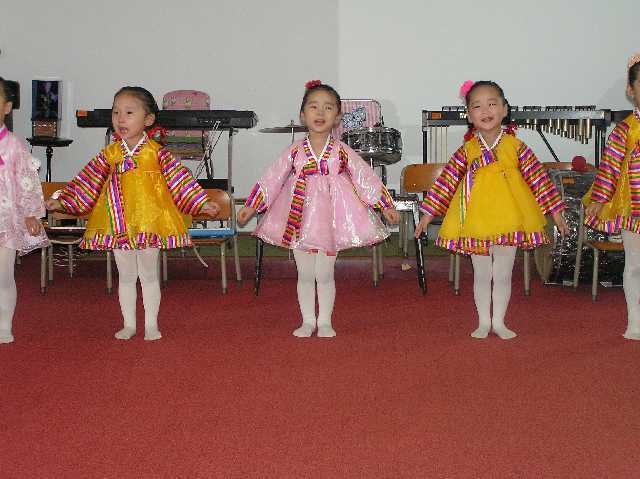
Nursery Rhymes (and Rhythms)
The Arirang was not the only entertainment for us. We visited a huge nursery school (childcare is provided gratis for all working families) where we were treated to performances (both vocal and instrumental) by some adorable pre-school DPRK citizens. They seemed delighted to see foreigners, and pulled out all the stops, including running up and clambering over us before we got out the door. Facilities were top notch - this nursery school was bigger than some others in the DPRK, being in Pyongyang, but we understand the same pattern is duplicated across the country.
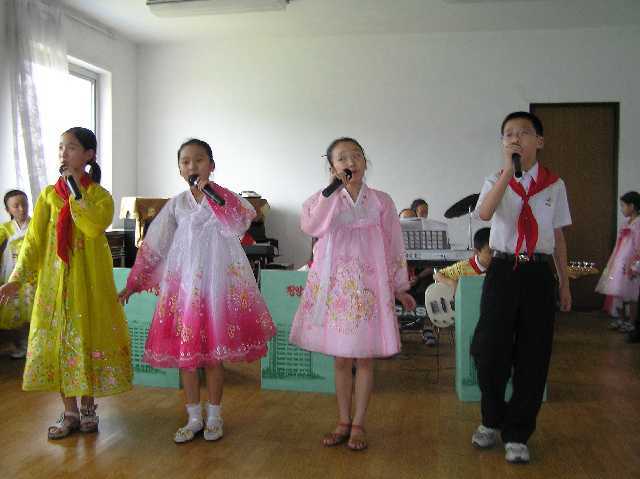
Elementary Entertainment
Also a feature of Pyongyang life is the Children's Palace, where we were treated to some vaudeville by elementary school children. Backing the singers was a quite competent young band, including piano, electric guitar, violin, drums, and numerous wind instruments. Children's lives are rather well organized with a wide choice of constructive activites. As you might imagine, as well as sports and music, scholarship is highly valued and amply rewarded. We were fortunate to run into six young men who had returned from France with high honors, two gold medals and four silver, from an international mathematics competition there. Very good showing for this relatively small Asian country (23,000,000 total, about 10% in Pyongyang, the capital).
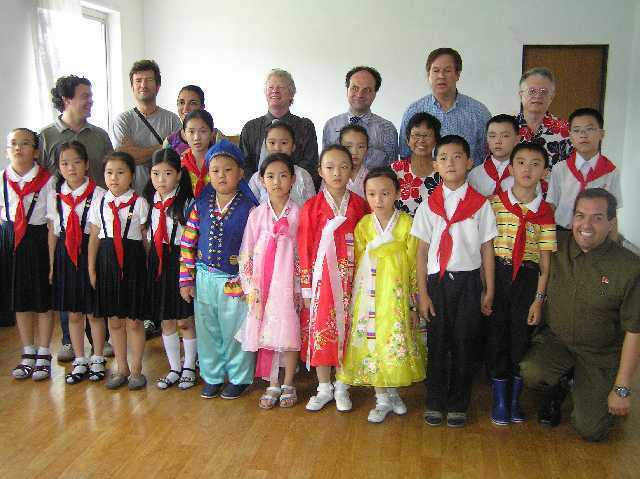
Tour Group and Friends
And here is a group shot with our entertainers in the foreground at the Children's Palace. Our tour guide, Alex, is also in the foreground on the right. Alex holds a Spanish passport, but he has been working for the DPRK 17 years now and speaks Korean fluently. We could not ask for a better guide. Amiable even when dealing with the occasional vexing problem that pops up, we could see him at his best even before we entered the DPRK. After we met Alex in Beijing to secure our DPRK visas, I found that I had miscalculated our budget. As Woody Guthrie said, it is highly unsanitary to be without money, so Alex spent precious time before we left Beijing running around with us trying to find a bank that would issue Euros (preferred to dollars in DPRK) on our Visa card. No luck here, so we eventually descended into the "bowels of hell" for it. We went into an overheated basement internet arcade (no air conditioning and hundreds of closely spaced computers with old CRT monitors belching like blast furnaces) and with some help from Alex and a couple of yuan rental, I was able to turn the trick over the internet. Our tour companions are in the background, left to right - Paulo, the impresario of spectaculars already introduced earlier, a young Spanish couple, Ernesto and Amalia, intrepid Australian businessman Frank, Rudi the Dutch lawyer and rail enthusiast, next George, amiable sport medicine doctor, the only other US citizen on the tour - he had been there twice before and was most helpful sorting things out for us, and there is me in back of a couple of Pioneers with their red scarfs. Cosy is there mixed in with the kids, whom she resembles, being the all-purpose Asian and about their size. You can always find her because of her loud clothes, which match mine. She had sewn all the outfits we wore on our trip. I say "loud", because dress in the DPRK is rather subdued (except for the folk costumes). Also you will not see a woman's bare shoulder, plunging neckline, or receding hemline on the street. There is no pornography, not even of the "semi" variety which sometimes predominates in much culture here. Alex claimed there was no crime to speak of; a point reinforced when I inadvertently left a package of postage stamps on our breakfast table, and they were in the same place when we returned in the evening. No one even thought it necessary to secure them away in a "lost and found".
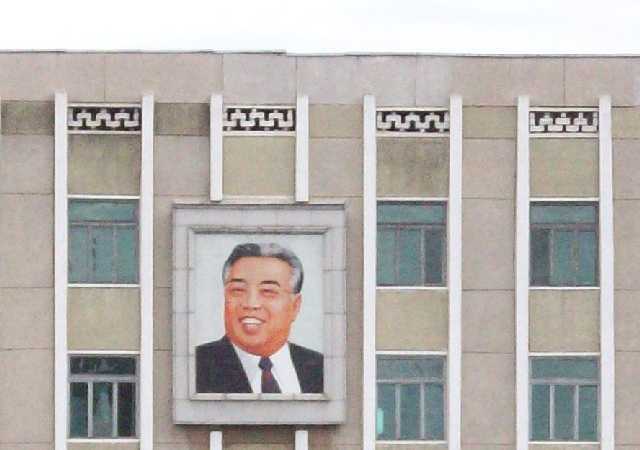
Kim Il Sung picture on building
You will see pictures of the Great Leader Kim Il Sung (deceased 1994) everywhere in the DPRK; in fact, many people there wear Kim Il Sung pins. Kim Il Sung is still an almost mythic or "holy" figure. His struggle against the Japanese occupation began in the 1920s and continued until the Axis defeat. A George Washington, Abe Lincoln, and V. I. Lenin rolled into one, he is known to many adults still alive. We visited his mausoleum, an enormous affair built within the first year of his death. Many thousands walk solemnly through it each day to view his carefully preserved body. Their sorrow at his absence is unmistakeable. The son, Dear Leader Kim Jong Il, actively involved in many phases of DPRK developments since early age, has picked up the mantle and seems to be made of similar stuff; there are almost as many pictures of him as well. Aside from the hands-on approach his father took to reconstruction and defense, the son has also been a key factor in the DPRK's cultural development. Music has flourished; we heard students playing a really beautiful instrument, invented by the Dear Leader, but based on folk designs and influenced by classical western strings. He has also had a major interest in DPRK cinema, directing some films himself. Most DPRK films have patriotic historical themes best appreciated by home audiences, but from the little we saw on television there, the acting and the cinematography looked first rate. We watched a thriller about a musician who smuggled anti-Japanese pamphlets in his violin case, and we understood roughly what was going on without subtitles. Films about the period during Japanese occupation, if subtitled, might actually go well here, as we were more or less on the "same side" then. I picked up a DVD version of a romantic comedy about female traffic controllers that could be a hit here if it had English subtitles.
We were told, however, that Kim Jong Il is the end of the so-called "dynasty". He does have children, but none seem headed for any such major positions. I wonder how the self-effacing custom of Koreans ascribing their own achievements to the influence of a Great or Dear Leader will change with a future, more "secular", national leadership?
I leave you with a couple of surprising tidbits about the DPRK. They recently issued a commemorative stamp proclaiming the DPRK to be the only tax-free country in the world. For all its audacious if defensive militarism, it has a totally volunteer army - there is no conscription. The economic growth rate in the DPRK was one of the highest in the world for a considerable period, even reaching 25% in the 1960s. It was less dramatic in the '70s and '80s, but the 1990s brought disaster. The Great Leader died, public grieving lasted for months. After he was gone, curiously all hell broke loose - two years of torrential floods destroyed their rice crops, they had already lost most of their trading partners due to the collapse of the socialist system, and the US was turning the screws on them with various kinds of boycotts. These hard times took thousands of lives, and severely impacted the development of the country for years. Instead of sympathy, much ado was made of their fledgling nuclear program, ironically by a country that had actually killed hundreds of thousands with the bomb, and in Korea's very neighborhood. Koreans, despite their historically grounded antipathy towards the Japanese, are much like them, and also remember the reported desire of MacArthur to atom bomb the north at one point in the Korean war.
We end this by asking - how can we move toward the One World One Dream on the Beijing billboard? Reunification of Korea is their own business, but most likely it will be a loose confederation of two systems rather than a single capitalist or socialist state. It does seem to be the feeling now even among the DPRK leadership, and there had been genuine moves toward this goal from both North and South. Just now, the South Korean government has a hard-line leader who temporarily scuttled the former "Sunshine Policy", but he is unpopular there now, and will likely be voted out. For us, we believe it is absolutely essential for the US to finally sign a peace treaty with the DPRK. Even though the Korean War is a forgotten chapter in many younger people's histories here, it remains a raw open sore in the DPRK. This should be followed by a great increase in cultural relations and trade. People like our Australian businessman tour companion already are starting this, to mutual gain. North Korea is rich in natural resources and skilled people. They want to trust, let us give them good reason to do so. The yardstick should not be whether we ourselves would want to live under the conditions that a terrible history has provided, each nation must go its way. Korean virtues emphasize consensus, family ties, hierarchical relationships, respect for age and authority, stability and tradition. If their way is a unique blend of confucianism and communism, ours has to be quite different.
For further study, I highly recommend historian Bruce Cumings' Korea's Place In The Sun. This book, covering both Koreas, the Japanese occupation, and the Korean War, provided enough background to help make sense of what we saw in our first brief glimpse of this enigmatic land. It will not be our last.
David Ecklein, Marcosa J Santiago MD. Cosy is a retired psychiatrist, David is still in the computer field.